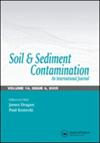Laboratory evaluation of a biodegradable surfactant for In Situ soil flushing
IF 1.5
4区 环境科学与生态学
Q4 ENVIRONMENTAL SCIENCES
引用次数: 9
Abstract
Laboratory studies were performed to examine the removal of NAPL m‐xylene from porous media using a biodegradable 5% sodium lauroy/sarcosinate surfactant flushing solution (Hamposyl L‐30, Hampshire Chemical Corp., Nashua, NH). Vertical glass columns were packed with 0.6‐mm glass beads or washed sand and contaminated with m‐xylene. Columns were drained by gravity so that the media initially contained three phases: air, water, and m‐xylene. Removal of m‐xylene was primarily by enhanced solubilization. Recovery of 95% of residual m‐xylene from washed sand was obtained with an average of 43.2 pore volumes of surfactant solution, as opposed to an estimated 477 pore volumes required when flushing with water alone. Addition of surfactants caused decreases in interfacial tensions and therefore column dewatering that resulted in decreased flow rates through the unsaturated media. Effluent samples were acidified to induce phase separation via formation of water insoluble sarcosine acid, which was observed as a whit...生物可降解表面活性剂在原位土壤冲洗中的实验室评价
实验室研究了使用可生物降解的5%月月酸钠/肌氨酸盐表面活性剂冲洗溶液(Hamposyl - 30, Hampshire Chemical Corp., Nashua, NH)从多孔介质中去除NAPL -二甲苯的情况。垂直玻璃柱用0.6毫米玻璃珠或洗砂填充,并被m -二甲苯污染。柱通过重力排干,因此介质最初包含三个阶段:空气,水和间二甲苯。对间二甲苯的去除主要是通过增强增溶作用。表面活性剂溶液平均孔径为43.2孔径时,可从洗砂中回收95%的残余m -二甲苯,而仅用水冲洗时所需孔径约为477孔径。表面活性剂的加入导致界面张力降低,从而导致柱脱水,从而导致通过不饱和介质的流速降低。对出水样品进行酸化,通过形成不溶于水的肌氨酸来诱导相分离,观察到其呈白色。
本文章由计算机程序翻译,如有差异,请以英文原文为准。
求助全文
约1分钟内获得全文
求助全文
来源期刊

Soil & Sediment Contamination
环境科学-环境科学
CiteScore
4.20
自引率
10.00%
发文量
53
审稿时长
2.2 months
期刊介绍:
When it comes to assessing and mitigating contaminated soils and sediments, there is no substitute for having the very latest tools, techniques and methodologies at your fingertips to help you deal with these issues efficiently and cost-effectively.
This is just the kind of essential expertise you’ll only find in Soil and Sediment Contamination . This internationally, peer-reviewed publication focuses on soil and sediment contamination from:
-Sludges-
Petroleum-
Petrochemicals-
Chlorinated hydrocarbons-
Pesticides-
Lead and other heavy metals.
Get detailed descriptions of all the latest and most efficient offsite and in situ remediation techniques, strategies for assessing health effects and hazards, and tips for dealing with everyday regulatory and legal issues. With the state-of-the-art tools that Soil and Sediment Contamination provides, you can successfully assess, mitigate, and solve both rural and urban soil contamination problems as efficiently and economically as possible.
 求助内容:
求助内容: 应助结果提醒方式:
应助结果提醒方式:


